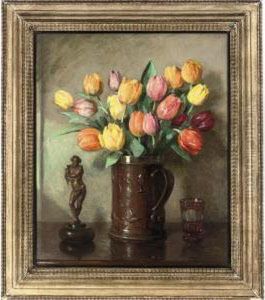Charles Kay Robertson Paintings
Charles Kay Robertson was an Australian artist, born in 1879 in Maitland, New South Wales. His artistic journey is a testament to the rich tapestry of early Australian art, reflecting a period of evolving styles and cultural influences. Robertson's work is characterized by its versatility, encompassing a range of mediums including painting, drawing, and printmaking. He is particularly noted for his landscapes and portraits, which capture the essence of Australian life and scenery during the late 19th and early 20th centuries.
Educated in Sydney, Robertson was part of a vibrant community of artists who were instrumental in the development of Australian art during this period. He traveled extensively within Australia, drawing inspiration from its diverse landscapes - from its bustling cities to its remote outbacks. His works often depict scenes with a remarkable sense of atmosphere and light, showcasing his skill in capturing the unique qualities of the Australian environment.
Robertson was an active participant in the Australian art scene, contributing to and exhibiting at various art societies and exhibitions throughout his career. Despite facing the challenges common to artists of his time, including financial instability and the struggle for artistic recognition, Robertson's dedication to his art remained unwavering. His contributions were not limited to his own artistic achievements; he was also a mentor and inspiration to younger artists, encouraging the growth and development of Australian art.
His death in 1935 marked the end of a career that had spanned over five decades, leaving behind a legacy that continues to be celebrated in Australian art history. Robertson's works are held in several Australian public collections, where they continue to be admired for their beauty and historical significance. Through his art, Charles Kay Robertson provides a window into the Australian soul, capturing the landscapes, people, and spirit of his time with enduring appeal.


